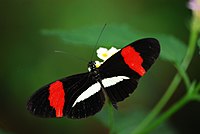
Photo from wikipedia
The choice of criteria to delimit a group or class is a subjective matter, even though the reasoning, the objectives and the criteria themselves should always be clearly stated. This… Click to show full abstract
The choice of criteria to delimit a group or class is a subjective matter, even though the reasoning, the objectives and the criteria themselves should always be clearly stated. This paper is part of a discussion about the criteria used to identify seminal fluid proteins (SFPs) in Drosophila species. SFPs are proteins that are transferred to females during copulation together with sperm. The only way to ascertain that a protein is an SFP is to prove that it is produced in a male reproductive organ and is found in the female reproductive tract after insemination. Nevertheless, the required methodology is labour‐intensive and expensive, and therefore this kind of data is unlikely to be available for many species, precluding comparative and evolutionary studies on the subject. To conduct evolutionary analyses, in a previous study, we capitalized on the accumulated knowledge we have in the model species D. melanogaster to recommend a set of criteria for identifying candidate SFPs in other Drosophila species. Those criteria, based on transcriptomic evidence and in silico predictions from sequences, would allow a good balance between sensitivity (the inclusion of true SFPs) and specificity (the exclusion of false positives). In view of the criticism raised by another group, here we defend our criteria on one hand while accepting there is room for improvement on the other. The results are updated sets of criteria and SFPs that we believe can be useful in future evolutionary studies.
Journal Title: Insect Molecular Biology
Year Published: 2022
Link to full text (if available)
Share on Social Media: Sign Up to like & get
recommendations!